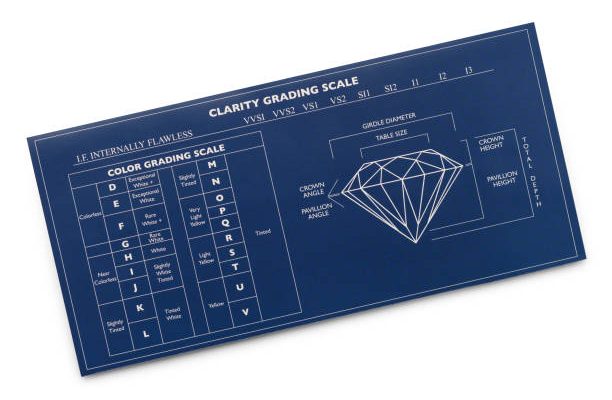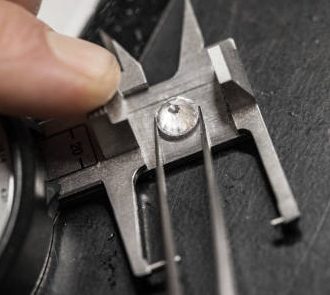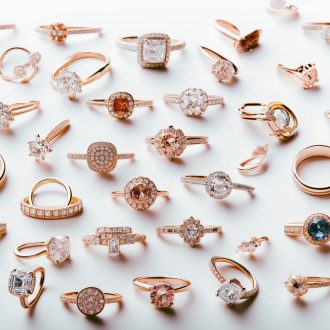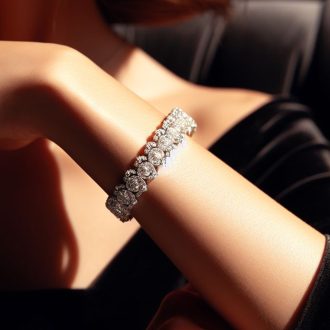
Starting on a journey to understand diamond certification takes us into a world where precision meets beauty effortlessly. In this exploration, we dive into the important aspects of certified diamonds, discovering the value found in diamond grading reports and the unmatched confidence they offer to buyers.
These reports, carefully created by experts in gemology, act as proof of a diamond’s realness, quality, and special features. As we explore the world of diamond certification, we uncover the secrets of the thorough evaluation processes that determine a diamond’s value. This adventure not only teaches us but also gives knowledge and confidence to fans and buyers alike, creating a deeper admiration for the enchanting charm held within every certified diamond.
The Essential Role of Gemological Laboratories in Diamond QualityGuardians of Quality: The Vital Role of Gemological Laboratories in Diamond Authentication
In a market full of stunning gems, it’s crucial to have a trustworthy standard. Gemological laboratories are key players in making sure diamonds are of high quality and real through thorough assessments. Amidst the sparkle of many gemstones, these labs are like strongholds of credibility. They carefully check a diamond’s color, cut, clarity, and carat weight to truly understand its special features. Relying on these respected labs is like having a helpful guide in the gemstone market. It ensures that consumers can make smart choices when looking for outstanding and real diamonds.
Diamond Certification Through Time: A Journey of Trust and Transparency
The story of diamond certification shows how much people have come to know about diamonds. From the beginning to now, certification has become a symbol of trust. It gives buyers strong confidence that the gemstones they want are real and good quality. As time passed, the certification process became more advanced. Experts now use high-tech methods to carefully check diamonds based on things like cut, color, clarity, and carat weight. This journey through history shows how knowledge has the power to change things. It helps people in the diamond market make smart choices. In simple terms, diamond certification proves the industry’s commitment to being clear and always striving to be excellent in every part of its shining history.
Diamond Grading Reports: Illuminating the Path to Informed Decisions
A diamond grading report is more than just a piece of paper; it’s like a special guide that tells us a lot about the gem. It’s not just for show — it’s really helpful for people deciding which diamond to choose. By looking closely at things like how it’s cut, its color, how clear it is, and its weight, the report shows us the diamond’s unique brilliance. In the world of diamonds, the grading report is like a good friend, helping us understand everything and giving us the knowledge to pick diamonds that match what we like and expect.
Diamond Insights: Exploring Key Concepts in Certification and Gemology
Certified Diamonds
Certified diamonds are those that have undergone thorough examination by an independent gemological laboratory. The resulting diamond grading report details the gem’s quality based on various parameters.
Gemological Laboratories
Gemological laboratories are specialized entities equipped with the expertise and tools needed to assess and grade diamonds objectively. They act as unbiased third parties, ensuring the accuracy of the diamond certification process.
Diamond Grading Report
A diamond grading report is a comprehensive document generated by gemological laboratories, providing a detailed analysis of a diamond’s characteristics. It includes information on the diamond’s cut, color, clarity, carat weight, and often includes a diagram illustrating the gem’s unique features.
Cut
The cut of a diamond refers to how well it has been shaped and faceted. It is a crucial factor influencing the gem’s brilliance and sparkle. Gemological laboratories assess the cut quality, considering aspects like proportions, symmetry, and polish.
Color
In diamond grading, color refers to the presence or absence of color in a diamond. The Gemological laboratories evaluate a diamond’s color on a scale, ranging from colorless to light yellow or brown, with each grade indicating subtle variations in hue.
Clarity
Clarity assesses the presence of internal or external imperfections, known as inclusions and blemishes, in a diamond. Gemological laboratories scrutinize a diamond’s clarity to determine its purity, using a scale that ranges from internally flawless to included.
Carat Weight
Carat weight is a measure of a diamond’s size, with one carat equal to 0.2 grams. Gemological laboratories accurately measure and report a diamond’s carat weight, providing buyers with a standardized unit for comparing and valuing diamonds.
Transparency
Transparency in the context of gemology refers to the clearness or purity of a diamond. A transparent diamond allows light to pass through it easily, enhancing its brilliance. Gemological laboratories assess transparency as part of the overall evaluation of a diamond’s quality.
Diamond Certifications: Beyond Quality Assurance – A Comprehensive Guide to Benefits and Beyond
Enhanced Confidence in Purchase: The certification process instills confidence in buyers, providing a transparent and standardized evaluation of the diamond’s attributes, ultimately leading to a more confident purchase.
Conflict-Free Guarantee:Certification often includes information on a diamond’s origin, ensuring it is ethically sourced and not associated with conflict zones. This benefits buyers seeking socially responsible and conflict-freegem options.
Customization Opportunities:Certified diamonds with detailed grading reports offer buyers the chance to tailor their preferences. Armed with specific information, consumers can choose diamonds that align precisely with their desired characteristics, allowing for a more customizationand satisfying purchase.
Insurance Premium Reduction: Certified diamonds are typically easier to insure, and many insurance companies offer lower premiums for diamonds with documented quality. The certification acts as proof of the gem’s value and characteristics, streamlining the insurance process.
Educational Resource:Diamond grading reports serve as educational tools, enlightening buyers about the unique features and qualities of their chosen gem. This knowledge empowers consumers to appreciate the intricacies of diamonds, fostering a deeper connection with their purchase.
Worry-Free Gifting:When presenting a certified diamond as a gift, the accompanying grading report offers reassurance to the recipient. The documented quality ensures that the diamond is a genuine and high-quality investment, enhancing the sentimental value of the gift.
Easier Upgrades:In the future, if a buyer decides to upgrade their diamond, the certification provides a clear record of the current gem’s attributes. This simplifies the upgrading process, allowing for a smoother transition and accurate valuation of the existing diamond.
International Recognition: Certification from reputable gemological laboratories provides international recognition and acceptance. This is especially beneficial for buyers who may travel or relocate, as the documented quality ensures the diamond’s value is universally acknowledged.
Protection Against Fraud: The detailed information in a diamond grading report acts as a safeguard against fraud. Buyers can confidently verify the diamond’s characteristics, protecting themselves from misrepresented or falsely advertised gems in the market.
Diamond Certification Guide: Navigating the Process for Informed Choices and Long-Term Assurance
Choose a Reputable Laboratory
Select a renowned gemological laboratory for certification to ensure credibility.
Submit the Diamond
Provide the gemological laboratory with the diamond for a comprehensive assessment.
Await the Report
Once the assessment is complete, patiently await the detailed diamond grading report.
Review the Report
Thoroughly examine the diamond grading report, paying close attention to details such as cut, color, clarity, carat weight, and any additional comments provided by the gemological experts.
Understand the Grading Scale
Familiarize yourself with the grading scale used by the laboratory, as it may vary. Gain insights into the significance of each grade to better comprehend the overall quality of the diamond.
Seek Clarifications
If any aspects of the report are unclear or if you have questions about the grading, don’t hesitate to reach out to the gemological laboratory for clarification. They are often willing to provide additional information to ensure your complete understanding.
Preserve the Report
Safely store the diamond grading report in a secure place, as it serves as an essential document for future reference, appraisals, or potential resale.
Update Insurance Coverage
If applicable, update or acquire insurance coverage for the certified diamond based on the information provided in the grading report. This step ensures proper protection against potential loss or damage.
Consider Customization
Using the detailed information in the grading report, explore opportunities for customization or setting changes that align with your preferences. This step allows you to tailor the diamond to your unique taste.
Diamond Certifications in Action: Real-Life Stories of Informed Choices and Enduring Value
A Collector’s Gem
As a passionate gem collector, Michael opted for certified diamonds to expand his collection. The grading reports became essential references, guiding him in acquiring unique gems with specific qualities.
International Traveler’s Security
Sarah, a frequent international traveler, invested in certified diamonds for their universal recognition. The detailed reports provided assurance and facilitated hassle-free customs procedures during her travels.
Wise Insurance Decision
John, mindful of potential risks, ensured his diamond was certified. When updating his insurance, the detailed grading report streamlined the process, resulting in adequate coverage and peace of mind.
Diamond Certification Pitfalls: Navigating Common Mistakes for a Confident Purchase
Neglecting Certification
Avoid the mistake of overlooking diamond certification, as it safeguards your investment.
Choosing an Unrecognized Laboratory
Selecting a lesser-known gemological laboratory can lead to inaccurate assessments. Choose wisely.
Ignoring the Grading Details
Failing to thoroughly review the grading details in the report is a common error. Take the time to understand the specific cut, color, clarity, and carat weight information to make informed decisions.
Assuming Uniform Grading Standards
Assuming that all gemological laboratories use the same grading standards is a misconception. Different labs may employ slightly varied criteria, so it’s crucial to be aware of the specific standards used by the chosen laboratory.
Relying Solely on Online Images
Depending solely on online images without verifying the diamond’s certification can be risky. Physical inspection and certification review are essential to ensure the diamond’s actual quality matches the visual representation.
Neglecting to Update Insurance
Forgetting to update your insurance coverage based on the information in the grading report is a common oversight. Keep insurance policies current to protect your investment adequately.
Overlooking the Fine Print
Overlooking any additional comments or fine print in the grading report can result in missed details. Pay attention to any notes or special considerations provided by the gemological experts.
Disregarding the Importance of Transparency
Disregarding the importance of transparency in diamond transactions is a mistake. Ensure that the certification and any accompanying documentation are shared openly during resale or customizations for a seamless process.
Neglecting Education
Neglecting to educateyourself about diamond grading and certification processes can lead to uninformed decisions. Take the time to understand the basics, empowering yourself to make confident choices.
FAQs
FAQ 1:What Information is Included in a Diamond Grading Report?
A typical diamond grading report includes details on the gem’s cut, color, clarity, and carat weight.
FAQ 2: Are There Different Grading Standards Among Gemological Laboratories?
Yes, different laboratories may have slight variations in grading standards, emphasizing the importance of choosing a reputable one.
FAQ 3:How Long Does the Diamond Certification Process Take?
The duration of the certification process varies among laboratories but generally takes anywhere from a few days to a couple of weeks.
FAQ 4: Can I Trust Online Diamond Certifications?
While some online certifications are reputable, it’s crucial to verify the credibility of the issuing laboratory. Opting for well-established and recognized online certification services can enhance trust.
FAQ 5: Do All Diamonds Need Certification?
While certification is not mandatory, it is highly recommended for ensuring transparency and understanding the quality of the diamond. It provides valuable information for both buyers and sellers.
FAQ 6:How Can I Verify the Authenticity of a Diamond Grading Report?
To verify the authenticity of a grading report, cross-reference it with the issuing laboratory’s database or contact the laboratory directly. Reputable labs often have online verification systems.
Summary
In the enchanting realm of diamonds, a diamond grading report serves as the eloquent narrator, crafting a compelling story that unveils the unique qualities of each stone. Beyond being a mere purchase, opting for certified diamonds transforms the acquisition into a strategic investment, fortified by precision and trust. The meticulous details encapsulated in the grading report, from cut and color to clarity and carat weight, not only authenticate the diamond’s identity but also empower buyers with a profound understanding of its individual brilliance. Thus, in the world of gemstones, a certified diamond becomes a timeless tale of precision and trust, embodying the essence of enduring beauty and value.



